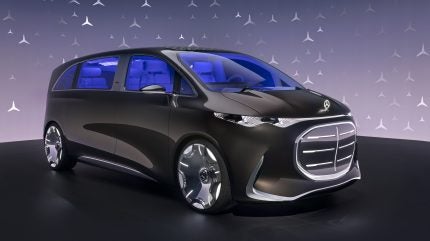
Mercedes-Benz
First came the statement that to tackle falling margins there would be a big push back towards luxury. Meaning high prices. However, there has been a rethink, while really, Mercedes-Benz has always offered a mix of big-ticket and lower-end vehicles. After all, the S-Class and so many light commercials all share the famous three-pointed star.

Discover B2B Marketing That Performs
Combine business intelligence and editorial excellence to reach engaged professionals across 36 leading media platforms.
A change which will soon be obvious is the unwinding of certain joint ventures, or parts of JVs. For example, whilst Geely and Horse remain partners (smart, engines for Mercedes passenger vehicles), manufacturing operations with Nissan-Infiniti are ending. And a vans alliance with Renault Group which hasn’t worked as well as had been expected, will stop building the T-Class and Citan in 2026 at Mauberge, a (Renault) factory in France.
A-Class gets a stay of execution
Suddenly, there is a frenzy of activity going on in the C-premium cars segment, the big three German rivals all rapidly altering their former plans to scale down or even leave the size class. Mercedes, which had at one time intended to kill off the A-Class and B-Class, will now extend the life cycle of the first of the pair at least, until 2028. The B-Class still faces the axe in 2026. Meanwhile, MMA will be the basis of a new crossover, effectively the A-Class replacement. Look for a launch in 30-32 months’ time.
Will Mercedes replace the EQA and EQB electric crossovers? The existing models haven’t been quite as popular as had been hoped for, though the EQA has had a strong 2025, Europe-wide deliveries totalling 31,365 during the first three quarters. As for the EQB, its sales numbered 25,490 so also now stands a good chance of going into a second generation. We should expect to see the successors in 2027/2028.

US Tariffs are shifting - will you react or anticipate?
Don’t let policy changes catch you off guard. Stay proactive with real-time data and expert analysis.
By GlobalDataOne of the brand’s newest models was announced in March, this being the CLA-Class. The 4,723 mm sedan is 35 mm longer, 25 mm wider and 29 mm taller than the outgoing car, while the boot is smaller than before (405 litres, compared to 460). However, electric versions add a 101-litre compartment under the bonnet. In addition to an estate (mainly for Europe), there is again a long body for China. The platform for all cars is MMA. An expected seven-year lifecycle means the mid-life facelift should happen in 2029.
C-Class EV coming in 2026
Joining the existing C-Class sedan and estate series next year will be electric versions. This has been confirmed by the company, as has MB.EA, the platform. Generation five of the model series, which dates to 2021, is overdue for a facelift, so that should happen at the same time as the arrival of the EV. This also means that the sixth generation could be as far off as 2030.
Now two years into its life cycle, the E-Class will therefore be due for a facelift in two years’ time, with a successor in 2030/2031. New powertrains should be part of the 2027 update for both sedan and estate. There will also be an EV to take on the BMW i5. This should therefore mean the end of the line for the EQE Sedan, a model which has failed to live up to expectations. The same applies to the EQE SUV, also set to be discontinued in 2026.
It may still have terrific looks but the S-Class, like all competitors, has faded in all markets. Mercedes will hope for a slight revival at least when it launches updated mild hybrid engines as well as a facelift in 2026. The next generation should then arrive in 2029.
No EQS Sedan successor
As the EQS Sedan has failed to find much success, there won’t be a direct replacement. Instead, the next S-Class will also be offered as an EV, i.e. no separate model with its own platform and bespoke body. Still, Mercedes is not giving up on the existing car: a major update is coming in 2026. This should include EVA2M, an enhanced version of the car’s platform, along with an 800V electrical system plus fresh batteries and motors. Furthermore, a two-speed transmission will likely also debut.
The G-line of SUVs and 4x4s continues to expand in some size segments. One such additional vehicle has been previewed already, at least in a silhouette rendering called g-Class. Notable exterior features on the outline shown to the media at the Munich IAA two months ago included a tailgate-mounted spare tyre. Insiders hint that the medium-sized rugged SUV should be built at Kecskemét (Hungary) commencing in 2027. To be launched as an EV, IC power should come later.
Due in the second half of 2026, a third evolution of the GLA-Class will again remain an ICE-native model. However, an electric variant should be available too and the GLA 3 might even be launched an EV with combustion engines following in 2027.
New GLB: no longer made in Mexico
Sharing its Mercedes-Benz Modular Architecture (MMA) with multiple other future vehicles, the next GLB-Class will be built at the Rastatt factory in Germany commencing in 2026. COMPAS, the Nissan JV in Aguascalientes, which manufactures the present generation, is to be closed it was confirmed a few weeks ago. The Mexican plant, which will produce Nissan vehicles into 2026, made its final GLBs earlier this month.
Premiering at the Munich IAA motor show in September, the next GLC is being perhaps bravely launched solely as an EV (‘GLC with EQ Technology’). Production bases for the new SUV – which features the MB.EA platform – are Bremen and Kecskemét, while the Beijing-Benz JV will manufacture a unique-to-China long-wheelbase model.
Mercedes’ CEO Ola Källenius stated in May that US build of the new GLC is also coming although not until the fourth quarter of 2027. Production should remain at all four locations until the successor steps in during 2033.
Next GLE and GLE Coupe
A very successful model, especially in the USA, the GLE moves to a fifth generation next year. The main production plant will again be Vance/Tuscaloosa in Alabama. The successor for the GLE Coupe may not arrive until 2027. Each should have an eight-year life cycle.
Two new high-priced MPVs are coming, as heralded by the Vision V show car which debuted at Auto Shanghai in April (see image). The model names will be VLE and VLS, their architectures also being new and known respectively as VAN.EA (Van Electric Architecture) and VAN.CA (Combustion). The first of the pair arrives in 2026. The E and S denote an intended relationship to the E-Class and S-Class in terms of sizing and pricing.
smart
Still a 50-50 JV between Mercedes-Benz and Geely Holding, smart can’t seem to get any traction in either Europe or China. These markets are the only ones where the brand has anything vaguely resembling a major presence.
Europe-wide sales amounted to just 9,048 cars during the year to the end of September, while for China, the corresponding total was 21,790. Can the brand survive? For now, the partners are backing it, and more models are coming. However, it’s all too easy to imagine either or both of the parent companies cutting their losses if there is no dramatic improvement in volume by, say, decade-end.
As of now, there are three models, these being badged #1 (SUV), #3 (coupe crossover) and #5 (MPV) with the #6, a fastback, soon to be revealed. Long gone are the days of smart being a brand which specialised in tiny cars, the size of the imminent hashtag six underlining this.
Zeekr 007 sires the smart #6?
Geely is said to have leveraged its Zeekr division to create the #6, insiders hinting strongly that the additional new car draws heavily on the Zeekr 007. Both electric and plug-in hybrid powertrains should be available. A PHEV drive system is also on the way for the #5, smart no longer being an electric-only brand.
Along with the hashtag five’s additional propulsion system, next year (or 2027) should be when the #1 and #3 receive their mid-cycle facelifts. An equivalent update for the #5 won’t arrive until 2028. But the biggest news is the long-awaited successor for the smart fortwo.
The #2 is due in “late 2026”, smart Europe GmbH stated on 2 September, noting that Europe would be the main market. This A segment model will be an EV and manufactured in China.






